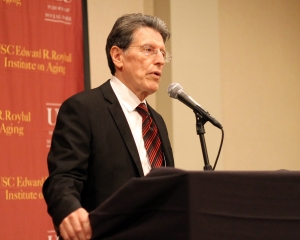International Conference Examines Health of Aging Hispanics
September 28, 2012 / by Vincent Lim- Research
More than 100 scholars convened for a three-day discussion about the health of aging Hispanics in the United States, Mexico, Latin America and the Caribbean, as part of the 2012 International Conference on Aging in the Americas hosted by the USC Edward R. Roybal Institute on Aging at the USC School of Social Work.
“We’re very happy to have you here in the context of the fact that we are an institute that is named after one of the great names in the history of the United States in Latino health and Latino aging,” William Vega, executive director of the USC Roybal Institute, told participants.
The September conference, timed to coincide with National Hispanic Heritage Month, focused primarily on issues related to research methodology, but speakers acknowledged the need to facilitate the translation of scientific findings to practical application.
“Much of our research sometimes struggles to find its import for pragmatic changes in prevention and the promotion of health and health care,” Vega said. “My urging is always to bring it closer to the action level: Think in advance when you write your research up, where are you trying to go with this in terms of where it will bring about change and influence policy.”
According to U.S. Census data, individuals of Hispanic origin are the nation’s largest ethnic/racial minority group, and Hispanics over 65 are the fast-growing segment of the older adult population in the United States.
“Latinos and their ship is about to arrive,” said Fernando Torres-Gil, the first-ever U.S. Assistant Secretary for Aging appointed under President Bill Clinton and the current director of the UCLA Center for Policy Research on Aging, who delivered the opening address. “The U.S., by 2050, will be a majority-minority nation, and Latinos will be the largest minority group.”
However, the ship will arrive along a route some may find surprising. Statistics have shown that immigration to the United States from Mexico has dramatically slowed in recent years, but birth rates for U.S. Hispanics have remained higher than those of non-Hispanic whites.
Torres-Gil, who provided an overview of national policy proposals aimed at addressing the issue of the aging of the U.S. population, stated that experts believe it is unlikely that another large wave of young, healthy immigrants from Mexico will arrive in the United States to offset the overall graying of the U.S. population.
“Immigration is close to zero,” Torres-Gil said. “There are some who may say that we may never again see the level of immigration that we’ve seen from Mexico and Central America and Latin America that we’ve seen before.”
Mexico’s population is also becoming much older, he noted.
“Mexico is no longer—what everyone perceives it to be—a young nation,” said Torres-Gil. “It’s getting older like the rest of us and the rest of the world.”
Luis Miguel Gutiérrez-Robledo, the director general of the National Institute of Geriatrics of Mexico, elaborated on the rapidly changing demographics of Mexico and showcased new data sets from his research team.
“Right now, we have as many people older than 60 as we do who are younger than five,” Gutiérrez-Robledo said, noting the trend is likely to continue, though some areas of Mexico are growing older more quickly than others. “The distribution is uneven and very heterogeneous.”
The conference—held in partnership with the Lyndon B. Johnson School of Public Affairs at The University of Texas at Austin, the Population Research Center at The University of Texas at Austin and The University of Texas Medical Branch—is the fifth installment in the series of meetings exploring the health and aging of Hispanic populations in countries such as Mexico and the United States.
“Most of what has been said during the meeting has practical implications for Mexico,” Gutiérrez-Robledo said. “This is knowledge that we should be sharing with several other teams in the National Institute of Public Health at Seguro Social and people who would be eager to collaborate and able to profit from this knowledge and transform it into public policy for Mexico.”
The conference series on aging in the Americas was established in 2001 at The University of Texas at Austin with the aim of utilizing research to augment knowledge about dimensions of healthful aging for people of Hispanic descent in the United States and Mexico.
“When we began this conference series back in 2001, we had a very small intimate group. Most of our participants were from Texas,” said Jacqueline Angel, principal investigator of the conference series. “Five installments later, we can see how diverse we are,” she said, referencing this year’s participants, who conduct studies in various regions of the world, including the United States, Mexico, Costa Rica and Argentina.
This year’s sponsors included the USC School of Social Work, The California Wellness Foundation, The California Endowment, Los Angeles Foundation on Aging, AARP, and the Austin Community Foundation.
To reference the work of our faculty online, we ask that you directly quote their work where possible and attribute it to "FACULTY NAME, a professor in the USC Suzanne Dworak-Peck School of Social Work” (LINK: https://dworakpeck.usc.edu)
